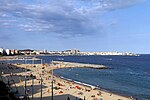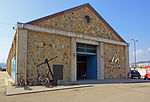S'Agaró

S'Agaró (Catalan pronunciation: [səɣəˈɾo]) is an upmarket resort on the Costa Brava between Sant Feliu de Guíxols and Platja d'Aro. It is part of the municipality of Castell-Platja d'Aro, itself in the comarca of Baix Empordà and province of Girona in Catalonia, Spain. The resort was developed from the early 1920s on the peninsular between the beaches of Platja de Sant Pol and Platja de Sa Conca.To date, the promontory contains about 60 exclusive houses and hotels. The world famous five-star Hostal de la Gavina dominates the view from Sant Pol beach. The original development has been declared as a historical complex and protected as a cultural asset of national interest since 1995.The GR 92 long-distance footpath, which runs the length of the Mediterranean coast of Spain, uses the historic camí de ronda that follows s'Agaró's coastline. The cami de ronda was rebuilt as part of the development, creating a walk in a semi-artificial landscape between sea, rocks and pines that integrates the urbanization with nature. To the north, the GR 92 crosses the beach of Sa Conca and diverts around the extensive Marina de Port d'Oro to reach Platja d'Aro. To the south it passes along the beach of Sant Pol to reach Sant Feliu de Guíxols.
Excerpt from the Wikipedia article S'Agaró (License: CC BY-SA 3.0, Authors, Images).S'Agaró
Avinguda de la Conca, Castell d'Aro, Platja d'Aro i s'Agaró
Geographical coordinates (GPS) Address Nearby Places Show on map
Geographical coordinates (GPS)
| Latitude | Longitude |
|---|---|
| N 41.7915 ° | E 3.05678 ° |
Address
Avinguda de la Conca
Avinguda de la Conca
17248 Castell d'Aro, Platja d'Aro i s'Agaró
Catalonia, Spain
Open on Google Maps








